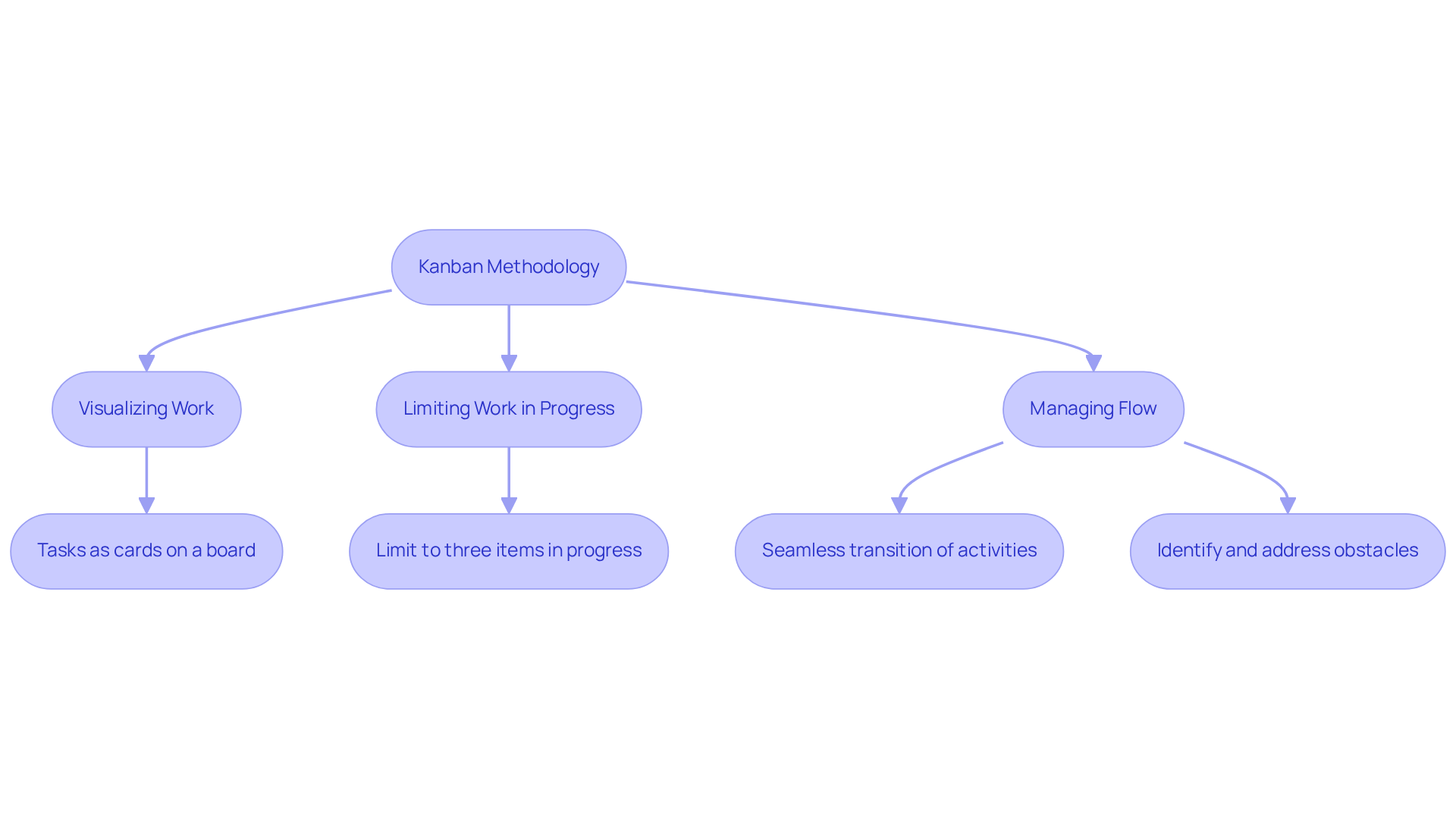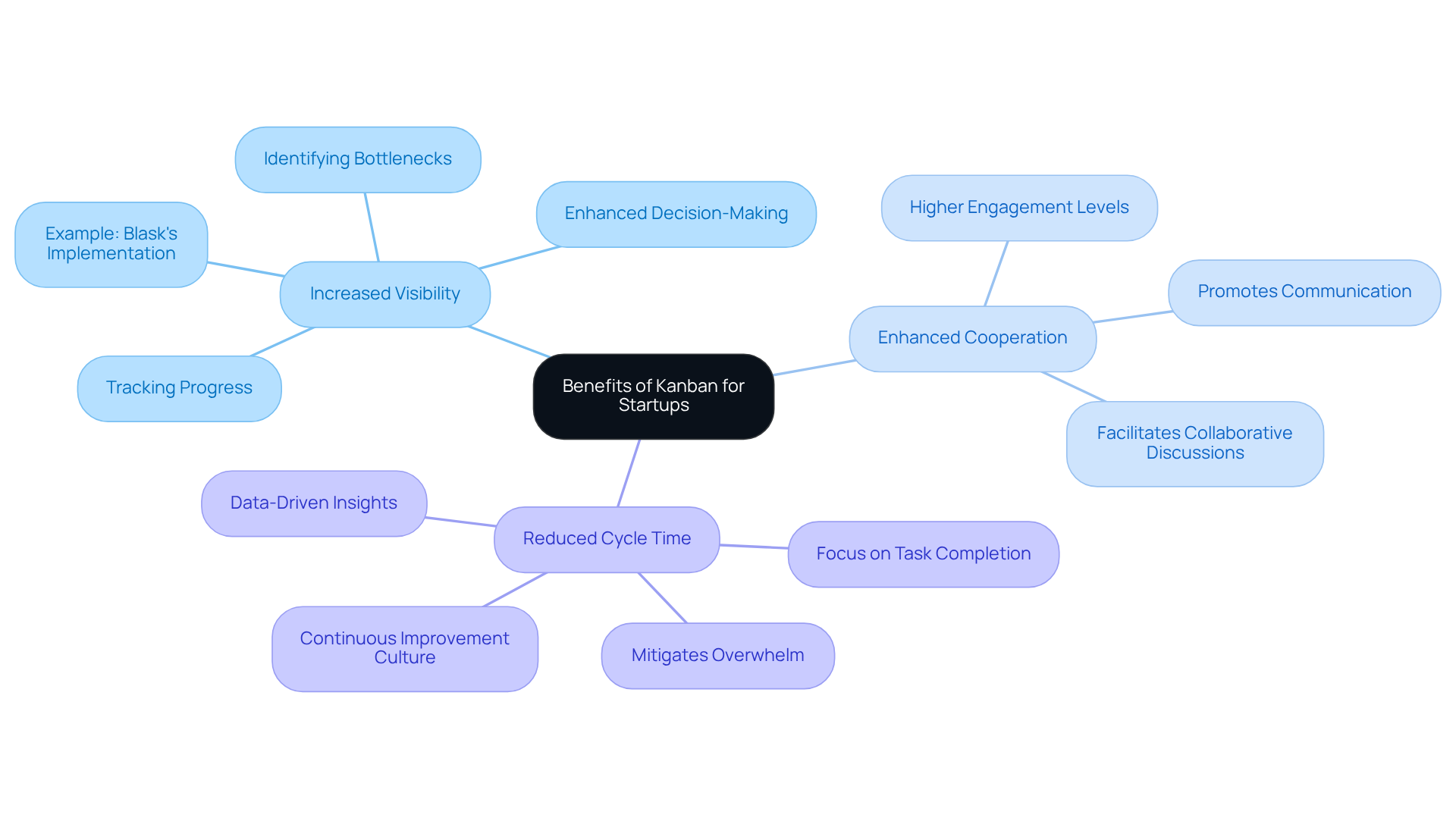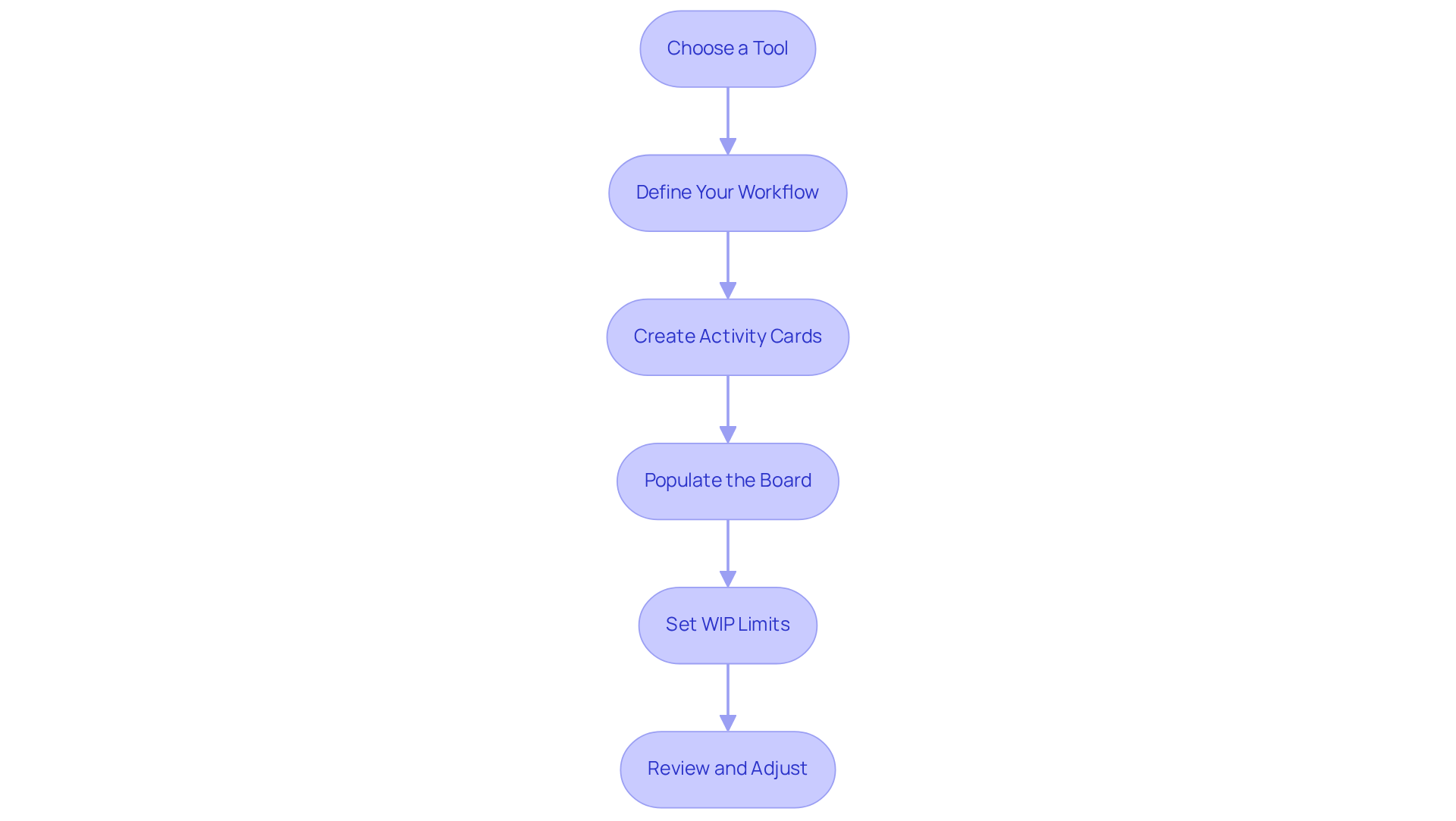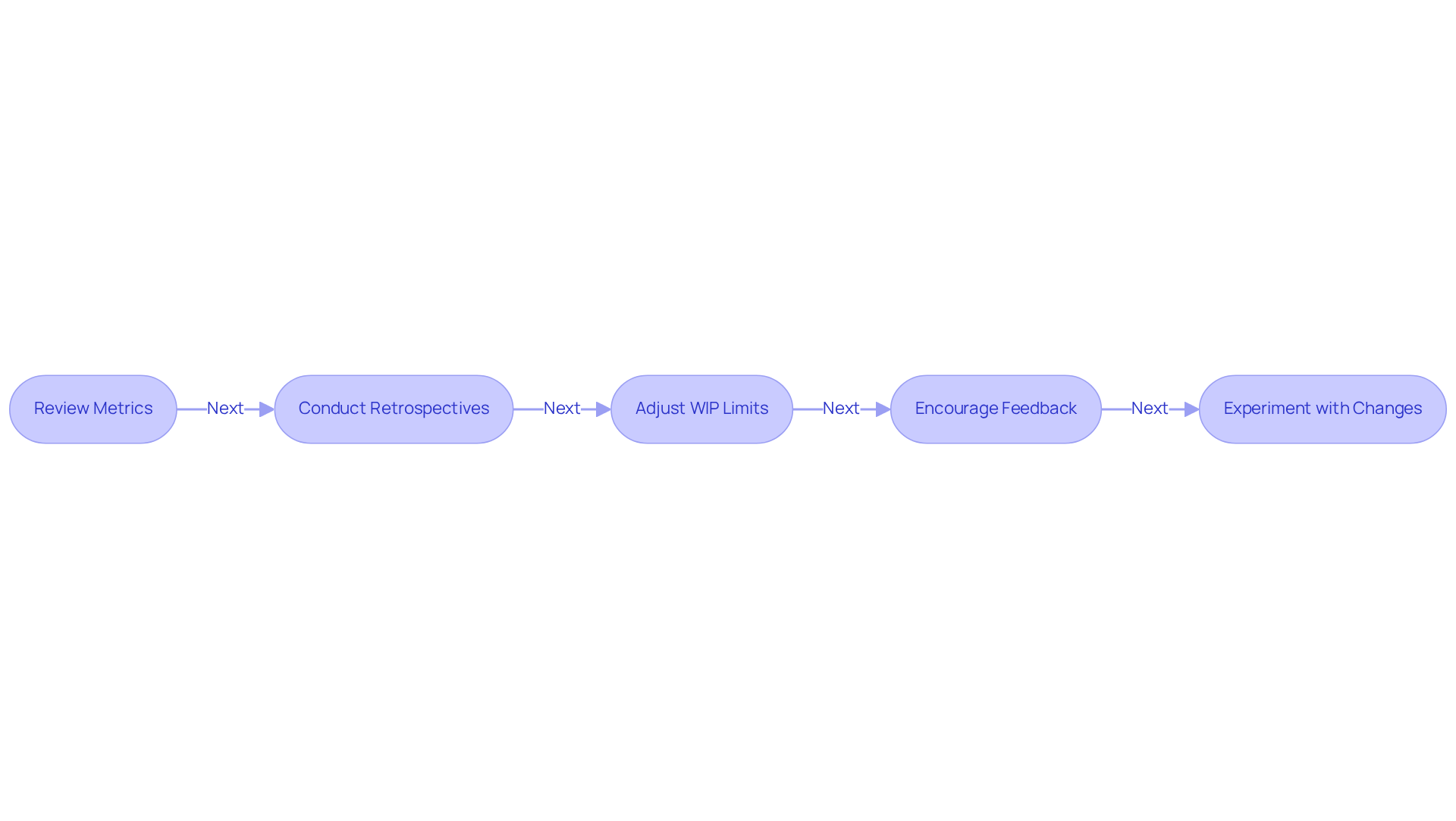Overview
The Kanban methodology is crucial for the success of startups, significantly enhancing workflow efficiency through the visualization of tasks, limiting work in progress, and managing flow effectively.
How does this methodology transform the operational landscape for startups? By implementing these principles, startups can achieve:
- Increased visibility
- Enhanced cooperation
- Reduced cycle times
This ultimately empowers them to adapt quickly to changing priorities and improve overall productivity. Embracing Kanban not only streamlines processes but also positions startups to thrive in a competitive environment.
Introduction
The Kanban methodology, deeply rooted in Toyota's production system, has emerged as a transformative approach for enhancing efficiency in startups. By visualizing workflows, limiting work in progress, and managing task flow, this system empowers teams to streamline processes and significantly boost productivity.
However, with the promise of increased operational efficiency comes the challenge of effectively implementing and optimizing this methodology within the fast-paced environment of a startup.
How can startups harness the power of Kanban not only to improve their workflows but also to adapt to the ever-changing demands of the market?
Understand the Kanban Methodology
This kanban methodology, originating from Toyota's production system, is designed to enhance efficiency through the clear visualization of tasks, limiting work in progress (WIP), and effective flow management. The core components of Kanban include:
- Visualizing Work: Tasks are represented as cards on a board, offering teams immediate visibility into the status of work. This clarity is essential for enhancing the flow of business value and fostering cooperation among team members.
- Limiting Work in Progress: The kanban methodology emphasizes limiting work in progress by establishing limits on the number of concurrent activities, which allows teams to effectively reduce bottlenecks and maintain focus on quality. For instance, a standard visual board may limit WIP to three items in the 'In Progress' column, promoting a more efficient workflow and enhancing overall productivity.
- Managing Flow: The kanban methodology focuses on managing flow by ensuring a seamless transition of activities from start to finish, swiftly identifying and addressing any obstacles that may impede progress. This principle is critical for startups, where adaptability to changing priorities is paramount.
Research indicates that organizations employing visual management techniques experience improved workflow efficiency, with an average lead time of just four days for tasks moving from 'To Do' to 'Done' and an average cycle time of 3.33 days. By visualizing workflows and implementing the kanban methodology, startups can refine their project management processes, ultimately leading to faster delivery of value and increased productivity. As emphasized by industry specialists, effective communication and visualization are vital for successful implementation, enabling teams to collaborate more effectively and respond to customer feedback and market trends. A case study titled 'Boosting Startup Efficiency with Lean Management' demonstrates how startups can adopt the kanban methodology by initiating with a simple board, clearly defining work items, and embracing a culture of learning and collaboration.

Identify the Benefits of Kanban for Startups
Implementing Kanban in a startup can yield numerous benefits, including:
-
Increased Visibility: Teams can easily track progress and identify bottlenecks, leading to better decision-making. This transparency is crucial for maintaining alignment and ensuring that all team members are aware of project statuses and challenges. For instance, Blask's application of the visual management system enabled them to enhance transparency in their development process, significantly boosting their operational efficiency. The kanban methodology provides enhanced flexibility by allowing for swift changes to priorities and tasks, which is essential in a dynamic startup environment where needs can shift rapidly. Such adaptability helps teams respond effectively to changing circumstances without losing momentum. Experts emphasize that this flexibility is vital for startups to thrive in competitive markets.
-
Enhanced Cooperation: The visual nature of the kanban methodology promotes communication among team members, ensuring everyone is aligned on project objectives. Regular updates and visual cues facilitate discussions, making it easier to address issues collaboratively. Industry insights reveal that teams utilizing the kanban methodology report higher levels of engagement and collaboration.
-
Reduced Cycle Time: By concentrating on completing tasks before initiating new ones, teams can deliver outcomes more quickly. This approach mitigates the risk of overwhelming members and enhances overall productivity. Data from various case studies indicate that teams employing agile methodologies have experienced a significant reduction in cycle times, leading to faster project completions. Ongoing enhancement in the kanban methodology encourages teams to consistently evaluate their workflows and implement gradual improvements, fostering a culture of development. This commitment to continuous improvement not only increases efficiency but also empowers team members to contribute to process optimization. Research indicates that startups utilizing a visual workflow method often experience notable enhancements in morale and productivity due to this emphasis on ongoing development.
These benefits position the kanban methodology as an ideal choice for startups aiming to streamline their workflows and maximize productivity. Successful implementations across various teams have demonstrated significant improvements in operational efficiency and team morale.

Set Up Your Kanban Board
To effectively set up your Kanban board, follow these essential steps:
-
Choose a Tool: Opt for a digital tool such as Trello, Asana, or Casy. These tools not only streamline project management but also integrate with chat platforms like Slack and Telegram, enhancing collaboration and reducing administrative overhead. Alternatively, consider a physical board for your Kanban setup.
-
Define Your Workflow: Clearly identify the stages of your workflow, typically represented as columns like To Do, In Progress, and Done. You may also include extra columns or swimlanes to better arrange activities based on priority or themes.
-
Create Activity Cards: Develop activity cards that outline each assignment, including deadlines and designated group members. This ensures clarity and accountability. Each card should represent a discrete item rather than a broad initiative.
-
Populate the Board: Arrange the cards within the appropriate columns based on their current status. This offers a visual representation of progress, helping to visualize blocked work and identify areas where assistance is needed.
-
Set WIP Limits: Establish Work In Progress (WIP) limits for each stage to prevent workload overload and maintain group focus. For instance, a group of five should set a maximum of five tasks in the In Progress column to enhance efficiency.
-
Review and Adjust: Conduct regular evaluations of the board with your group to ensure it accurately reflects current priorities and workflows. Create a feedback-friendly environment to promote group involvement in the workflow, enabling essential modifications based on input.
By applying these measures, you can develop a versatile task board that greatly enhances your group's efficiency and simplifies project management through the kanban methodology.

Manage and Optimize Your Kanban Process
To effectively manage and optimize your Kanban process, consider implementing the following strategies:
- Regularly Review Metrics: Consistently track key performance indicators such as cycle time, lead time, and throughput to evaluate your team's efficiency. This data is crucial for identifying areas for improvement and ensuring that your workflow remains aligned with your startup's goals. Utilizing AI tools can further enhance this process by examining data and forecasting trends, offering deeper insights into your performance metrics.
- Conduct Retrospectives: Schedule regular meetings to reflect on successes and challenges within your Kanban process. These retrospectives are essential for nurturing a culture of ongoing enhancement, enabling teams to adjust and perfect their practices based on shared insights. They also assist in recognizing bottlenecks and improving group efficiency, ensuring that the workflow remains smooth.
- Adjust WIP Limits: Tailor work-in-progress limits according to your group's performance metrics. This adjustment helps optimize flow, minimizes bottlenecks, and enhances overall productivity. Remember, respecting WIP limits is essential for the effective implementation of the system.
- Encourage feedback by fostering an open atmosphere where team members feel at ease sharing their thoughts on the Kanban methodology. This input is vital for identifying potential improvements and fostering a sense of ownership among team members. As George Gaievsky noted, being willing to experiment and learn from mistakes is key to finding a workflow that supports your goals.
- Experiment with Changes: Implement small, incremental changes to your workflow and monitor their effects. This approach allows for data-driven decisions that can lead to significant enhancements in efficiency and effectiveness. Evaluating one method at a time can assist in determining the impact of these modifications.
By actively managing and optimizing your Kanban process, you can ensure it remains effective and continues to support your startup's growth.

Conclusion
Implementing the Kanban methodology can significantly transform the operational landscape of startups, fostering efficiency and enhancing productivity. By emphasizing task visualization, limiting work in progress, and managing workflow effectively, Kanban equips teams with the tools necessary to adapt swiftly to changing demands while maintaining a clear focus on delivering value.
In this guide, we have explored the benefits of Kanban for startups in depth. The increased visibility and transparency it provides facilitates better decision-making and enhances team collaboration. Moreover, the methodology's ability to reduce cycle times and promote a culture of continuous improvement underscores its value, as evidenced by various case studies showcasing successful implementations across diverse teams.
Ultimately, adopting the Kanban methodology transcends mere workflow improvement; it fosters an environment of adaptability and collaboration essential for startup success. Are you ready to embrace these principles? Doing so can empower your teams to thrive in competitive markets and encourage a proactive approach to project management. Startups are urged to explore the Kanban framework and consider its potential to streamline operations, enhance team morale, and drive sustained growth.
Frequently Asked Questions
What is the Kanban methodology?
The Kanban methodology is a system designed to enhance efficiency through the clear visualization of tasks, limiting work in progress (WIP), and effective flow management, originating from Toyota's production system.
How does the Kanban methodology visualize work?
In Kanban, tasks are represented as cards on a board, providing teams with immediate visibility into the status of work, which enhances the flow of business value and fosters cooperation among team members.
Why is limiting work in progress (WIP) important in Kanban?
Limiting WIP is crucial as it establishes limits on the number of concurrent activities, helping teams reduce bottlenecks and maintain focus on quality, ultimately promoting a more efficient workflow.
How does Kanban manage flow?
Kanban manages flow by ensuring a seamless transition of activities from start to finish and swiftly identifying and addressing any obstacles that may impede progress, which is particularly important for startups that need to adapt to changing priorities.
What benefits do organizations experience from using visual management techniques in Kanban?
Organizations using visual management techniques experience improved workflow efficiency, with an average lead time of four days for tasks moving from 'To Do' to 'Done', and an average cycle time of 3.33 days.
How can startups benefit from implementing the Kanban methodology?
By visualizing workflows and adopting the Kanban methodology, startups can refine their project management processes, leading to faster delivery of value and increased productivity.
What role does communication play in the successful implementation of Kanban?
Effective communication and visualization are vital for successful Kanban implementation, enabling teams to collaborate more effectively and respond to customer feedback and market trends.
What is a practical approach for startups to adopt the Kanban methodology?
Startups can begin adopting the Kanban methodology by initiating with a simple board, clearly defining work items, and embracing a culture of learning and collaboration, as demonstrated in the case study 'Boosting Startup Efficiency with Lean Management'.




